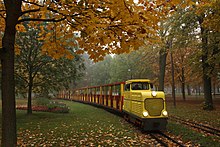Prater
| Prater | |
|---|---|
 Wiener Riesenrad in the Wurstelprater amusement park | |
 | |
| Location | Leopoldstadt, Vienna, Austria |
| Area | All of the Prater (1859): ≈1,500 acres (6.1 km2)[1] All of the Prater (2008): ≈6,000,000 square metres (1,500 acres)[2] The Green Prater (German: Grüne Prater) only (2022): ≈3,271,947 square metres (808.516 acres)[3] |
| Created | 7 April 1766 (public) |
| Website | Prater: www Green Prater: www |
The Prater (German pronunciation: [ˈpraːtɐ] ⓘ) is a large public park in Leopoldstadt, Vienna, Austria. The Wurstelprater, an amusement park that is often simply called "Prater", lies in one corner of the Wiener Prater and includes the Wiener Riesenrad Ferris wheel.
Name[edit]
The name Prater derives from one of two Latin words (or possibly both): pratum 'meadow' or praetor 'magistrate, lawyer', possibly via Spanish prado or Italian prato.[citation needed]
History[edit]


The area that makes up the modern Prater was first mentioned in 1162, when Emperor Friedrich I gave the land to a noble family called de Prato. The word "Prater" was first used in 1403, originally referring to a small island in the Danube north of Freudenau, but was gradually extended to mean the neighbouring areas as well. The land changed hands frequently until it was bought by Emperor Maximilian II in 1560 to be a hunting ground. To deal with the problem of poachers, Emperor Rudolf II forbade entry to the Prater. On 7 April 1766, Emperor Joseph II declared the Prater to be free for public enjoyment, and allowed the establishment of coffee-houses and cafés, which led to the beginnings of the Wurstelprater. Throughout this time, hunting continued to take place in the Prater, ending only in 1920.
The 1873 Vienna World's Fair was held in the Prater. A large area was set aside for the fair, centered on the Rotunde (English: Rotunda). The Rotunde was built for the occasion of the World's Fair, and was the fair's largest building. The Rotunde was destroyed by a fire in 1937. While it stood, its dome was the largest in the world. The former site of the Rotunde is now occupied by buildings associated with the Messe Wien, and with the Vienna University of Economics and Business.
On the grounds of modern-day Kaiserwiese, an attraction called "Venice in Vienna" was established in 1895 by Gabor Steiner. The area included an artificial lagoon to simulate the canals of Venice, Italy.
Due to development, the Prater has shrunk significantly over time. For instance, the Prater used to include the land that is now the Hafen Freudenau (Freudenau Harbor), and the Stuwerviertel.[citation needed]
In 1978, part of the Prater was designated the "Green Prater" (German: Grüne Prater), and was placed under "landscape protection" (German: Landschaftsschutz).[3]
In 2004, major renovations to the Wurstelprater began, and a new underground railway line was finished and brought into service on 11 May 2008, which includes three stops along the Prater (see Vienna U-Bahn). Wien Praterstern railway station has been in operation for a long time and is only a few dozen metres away from an entrance to the park.
The overall area of the park has also been reduced by the building of the Ernst-Happel-Stadion (Austria's national stadium), the Südosttangente (Austria's busiest motorway), and the Trabrennbahn Krieau (a harness racing track). In 2013, the new campus of the Vienna University of Economics and Business was opened next to the Prater.
In 2019, Eliud Kipchoge ran the marathon distance of 42.195 km on a stretch of road in the park in the INEOS 1:59 Challenge. His time of 1:59:40 was the first time anyone had run the marathon distance in under two hours.[4]
Other attractions[edit]


The Hauptallee (main avenue) is the main artery, lined with horse chestnut trees, closed to motorists and known to sports enthusiasts from the annual Vienna Marathon. The Wiener Prater is home to the Liliputbahn, a narrow gauge railway. Another unusual object to be found in the Wiener Prater is the Republik Kugelmugel (Republic of Kugelmugel), a spherical micronation. The Wiener Prater also houses a planetarium and the Prater Museum.
The Hauptallee is the venue for about 30 organized running events every year, including the Vienna City Marathon and the Austrian Women's Run. The tradition started in 1822, when races were held between professional runners and Vienna nobility. In 2022, it was awarded the World Athletics Heritage plaque for its contributions to the sport of running.[5]
See also[edit]
References[edit]
- ^ Crane, Samuel D. [Dexter]; Committee on the Improvement of the Public Garden (1860) [1859-10-31]. "City Document.—No. 63. City of Boston. : Report of Committee on the Improvement of the Public Garden. 1859.". Documents of the City of Boston, for the Year 1859. Vol. II : Containing Documents from No. 24 to No. 79, Inclusive. Boston: Geo. C. Rand & Avery, City Printers. p. 4. Retrieved 12 September 2023.
The Thiergarten, in Berlin, contains over 200 acres; the Prater, in Vienna, about 1500 acres
- ^ "Wiener Stadtgärten". Der Wiener Prater (in German). Archived from the original on 2 May 2008. Retrieved 12 September 2023.
Größe: rund 6.000.000 Quadratmeter
- ^ a b "Der grüne Prater". wien.gv.at (in German). Archived from the original on 29 January 2022. Retrieved 12 September 2023.
Größe des grünen Praters: rund 3.271.947 Quadratmeter
- ^ Andrew Keh (12 October 2019). "Eliud Kipchoge Breaks Two-Hour Marathon Barrier". New York Times. Retrieved 12 October 2019.
- ^ "Prater Hauptallee | List of Plaques | Heritage | World Athletics". worldathletics.org. Retrieved 11 April 2024.
External links[edit]
- Official website
- Information about the Green Prater from the City of Vienna (in German)
- Information about the Prater from the tourism office of the City of Vienna
- Information about the Green Prater from the tourism office of the City of Vienna
- Liliputbahn miniature railway (in German)
- Schedule of events at the Prater in 2012 at the Wayback Machine (archived 2016-03-04)

